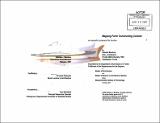Mapping form/ constructing context : an operatic proposal for Boston
Author(s)
Mendoza, Rolando (Rolando Jose), 1966-
DownloadFull printable version (13.89Mb)
Other Contributors
Massachusetts Institute of Technology. Dept. of Architecture.
Advisor
Fernando Domeyko.
Terms of use
Metadata
Show full item recordAbstract
This thesis explores the relationship between form, context, and program through the optic of sound. The project consists of an open assembly of receptive surfaces (a multiple membrane system) that register and retrace different music tempos and acoustical events from the interior and the city's vibrations, rhythms, noises and breath, from the exterior. The oscillating effect between these parameters begins to define a thickened zone of space that mediates program and context through its deployment of surface, facade, flow and structure. It is this deployment that becomes critical- it becomes a way of constructing one's own context- a coordinate system that belongs only to the project at hand. This coordinate system is a resultant of the mapping of forces- a diagramming of flows and influences that are present in the site, the program, the project and its methodology. A formal strategy evolves that is discovered rather than implemented, and as a result, the internal logic of the project becomes the generative mechanism (evolutionary) that sets in motion its transformations, deflections and formulation. Ultimately the thesis proposes a way of dealing with the gap that exists between intuition and science, and decides where it positions itself along this bar. The computational model is developed initially from intuitive readings and mappings of the site- this intuition is then transferred into a context, or framework that can be tested. This testing becomes a critical part of constructing context- it is through testing that the intuitive meets the rational and calibrates the internal logic of the project.
Description
Thesis (M.Arch. and S.M.)--Massachusetts Institute of Technology, Dept. of Architecture, 2001. Includes bibliographical references (p. 72-74).
Date issued
2001Department
Massachusetts Institute of Technology. Department of ArchitecturePublisher
Massachusetts Institute of Technology
Keywords
Architecture.